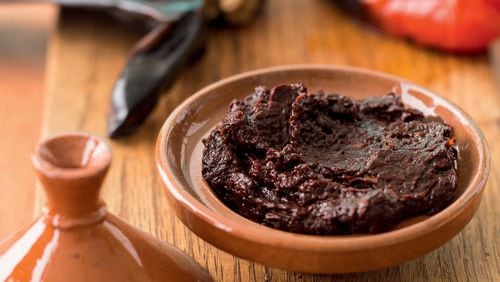Fermentation has an impact on many of the foods we eat and enjoy.
Think pickles, sauerkraut, kimchi and soy sauce. Or miso, yogurt, cheese and sourdough bread.
And, of course, the wine and beer we drink had its beginnings in bubbling vessels inoculated by wild microorganisms.
Nowadays, fermentation has become a thing.
On one hand, the growing interest has been fueled by the quest for a healthier diet in the form of probiotics and good gut flora.
On the other hand, high-profile chefs like David Chang and Edward Lee have made it the focus of efforts to discover new and exotic flavor profiles on a spectrum that runs from tangy to rotten-ripe.
A guru of the movement, author and activist Sandor Ellix Katz changed the game when his 2013 James Beard award-winning book, “The Art of Fermentation” (Chelsea Green Publishing, $39.95), became the go-to guide for do-it-yourself home fermentation revivalists.
This year, another wave of fermentation books hit the shelves, each offering a slightly different take on the trend, along with recipes and tips for home cooks.
“Fermentation on Wheels” by Tara Whitsitt (Bloomsbury, $27) is essentially a travel diary by the young artist, food activist and fermenter.
Subtitled “Road Stories, Food Ramblings, and 50 Do-It-Yourself Recipes,” Whitsitt chronicles her adventures driving around the country in her 1986 International Harvester bus, preaching and teaching fermentation along the way.
“I got interested in fermented foods after learning how to make sauerkraut from a friend I’d met at the farmers market,” Whitsitt says. “I was completely mesmerized and inspired by the process. It was kind of like tending a garden, but in my kitchen.”
Whitsitt admits she’s been surprised by the response to her project, including the New York Times cover quote calling her “The Johnny Appleseed of pickling.”
“I don’t think my friends and family got what I was doing,” she says. “They thought it was risky and dangerous driving a 40-foot bus around the country.
“But people have really supported me and I think more people are considering the historical power of these more primitive processes and what they did for our ancestors. Fermented foods are nutritional powerhouses.”
As the title signals, “Traditionally Fermented Foods” by Shannon Stonger (Page Street Publishing, $22.99) gets back to the basics with takes on old-fashioned techniques and time-tested recipes.
Stonger is a chemist who lives with her husband and five children on a five-acre homestead in Texas, so much of what she shares is part of her daily life, presented with precise scientific methodology.
“After I had my first child, I started to read about nutrition, and fermented foods just kept coming up,” Stonger says. “I wanted to feed my children as well as I could, so I just started by making yogurt.
“My interest in fermentation skyrocketed after we moved off the grid and I needed to find ways to preserve food without refrigeration or even canning. I needed to feed my family.”
As far as getting into fermentation, Stonger advises home cooks to begin with what they like to eat.
“Go for something you’re familiar with,” she says. “If you already like yogurt, start there. If you like kimchi, try making it. But you need to learn over time by doing it over and over again.
“Mostly I hope more than just being trendy, this trend will grow. I don’t think most people realize how important the microbiome is, and the gut is, and how related it is to our immune system and overall health.”
“Fiery Ferments” by Kirsten Shockey and Christopher Shockey (Storey Publishing, 24.95) takes a culinary approach to the subject with recipes for the likes of hot sauce, spicy chutney, kimchi and other condiments.
The Shockeys, who live on a 40-acre farmstead in Oregon and teach fermenting classes and workshops, started out creating cultured vegetables and krauts to sell through their food company.
“We actually started with a Christmas gift from my mom, who was an early adopter of fermented foods,” Kirsten Shockey says. “In 2009, we wanted to start a business and decided on fermented vegetables because it’s so easy and safe. But it wasn’t quite cool then, like it is now.
“It’s still not fully mainstream, yet, but the growth is definitely in that direction. I’m starting to see gastroenterologists come to our classes. And I’m starting see people come to our classes because their mainstream medical doctor is recommending that they eat these foods.”
Shockey admits that the biggest hurdle in acclimating people to the ways of fermentation is a preconceived notion about food safety.
“We’ve grown up with the germ theory,” she says.“So stick it on your counter for two weeks and then stick your fork in it and that’s OK? A big part of what we’re doing is helping people see that not only is it safe, it can’t kill you. And it can help you feel so much better.”
The recipes from “Fiery Ferments,” “Traditionally Fermented Foods” and “Fermentation on Wheels” offer an intro to basic fermentation while revealing how microorganisms can transform the simplest ingredients into flavorful and healthful dishes.
Combine equal parts flour and water in a ball jar, and to make it breathable, cover with a cloth and secure with a rubber band.
Any type of flour will work. Try brown rice flour for a gluten-free option.
Add a handful of organic grapes or raisins to jump-start the fermentation process.
Store in a warm place and stir once a day for five to seven days, until starter shows signs life (growth and bubbles). Feed with equal parts flour and water to keep it going.
Use starter in place of yeast, according to recipe. Allow extra time for the rise.
To feed and keep your starter: When not in use, store in the fridge. Pour half out, and add equal amounts flour and water weekly to restore. Otherwise, refresh daily and use often.
Adapted from “Fermentation on Wheels” by Tara Whitsitt (Bloomsbury, $27)
About the Author






